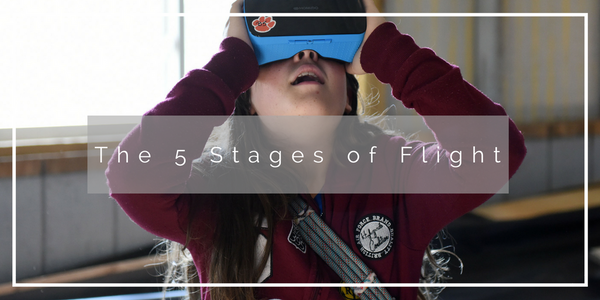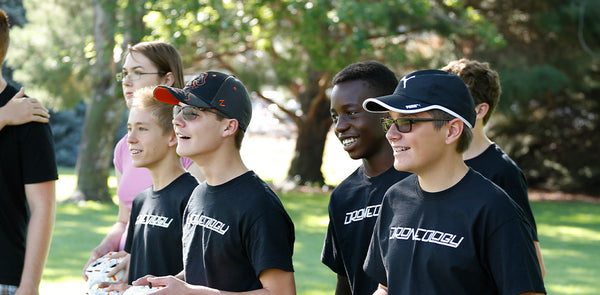
How to Introduce Elementary Students to UAV Technology
So, you’ve decided to introduce a drone education program to your elementary students. You’ve done the research, seen what’s available on the market and know that being a pilot isn’t as simple as just firing-up a drone.  You want a program which not only teaches your learners to fly but also immerses them in the safety, skills and regulations of piloting. You need a program that finds a way to marry the fun of flight with the immense opportunities of learning through an aerial robotics platform.
You want a program which not only teaches your learners to fly but also immerses them in the safety, skills and regulations of piloting. You need a program that finds a way to marry the fun of flight with the immense opportunities of learning through an aerial robotics platform.
Your drone program needs substance.
So, how do you do it? Join the Mini Drone Revolution! With mini drones, your students learn to fly on smaller, simpler and more adorable UAVs, all from the comfort of their classroom or gymnasium. By shrinking the drones, STEM lessons are also simplified, allowing students to interact with new concepts and ideas through a welcoming, thrilling, safe and fun learning platform.
Mini drones can be the perfect educational tool for your classroom, but they can also flop if they’re not accompanied by the right curriculum. Luckily, you have the 5 Stages of Flight below —Are you ready to make mini drones the perfect introduction to UAV Technology?
1. Essential Knowledge
As a drone pilot, there are just certain things you need to know. Like knowing which direction to run around the bases or how to swing a bat, piloting isn’t like T-Ball. There are a number of concepts you need to know before stepping into the batter’s box.
Things like:
- What Is A Drone?
- The History of Drones
- A Drone’s Components
- How Drones Fly
- And Important Drone Terminology
Now, I know what you’re thinking — “the amount of research, prep and curriculum building required to cover these topics… are mini drones even worth it?” Well, yes, they are! There are tools out there to help eliminate your work behind the scenes as your prepare to introduce drones to your students. It’s why PCS Edventures created Droneology, an online drone education platform that introduces students to drone fundamentals, safety and real-world applications.
As lifetime learners and educators ourselves, we know exactly how much work goes into introducing new concepts to students. And with emerging technologies like drones, we know that the preparatory work becomes all the harder and even more critical. With Droneology, topics like the History of Drones are as simple as pushing play.
2. Flight Safety
Before you’ve started any project or looked to learn a new skill, one of your first lessons has always been safety. It’s why refrigerators come with a packet of warnings and cautions, and why freshman aren’t allowed to use the table saw the first day of woodshop. Before you can succeed, you need to learn how to succeed safety. The same thing goes for drones.

While mini drones are the smaller, safer packages than their larger quadcopter cousins, there’s always a small risk that comes with flying a mechanical object. That’s why it’s important that your learners understand that while drones are fun, there are also strict rules to follow. By picking up the drone’s radio controller, you’re also adopting safety responsibilities.
Now, with the built-in safety features of mini drones, your worst-case scenario may only be a seriously bad case of tangled hair — but the rules are important.
 They set the foundation for your pilot's to continue to build and evolve within the drone learning space in a safe and secure environment. Just like how driver’s training sets you up for a lifetime of safe travel, your drone program needs to place safety as its highest priority.
They set the foundation for your pilot's to continue to build and evolve within the drone learning space in a safe and secure environment. Just like how driver’s training sets you up for a lifetime of safe travel, your drone program needs to place safety as its highest priority.
3. Basic Piloting Skills
Learning to fly needs to be a slow process. As the saying goes, you need to learn to walk before you can run, and with drones, you need to master basic piloting skills before you can take-off into uncharted airspace.
Every beginning pilot needs to master:
- Startup and Shutdown
- Take-off
- Hovering
- Climbing
- Descending
- Turning
- Landing
These are the basics of drone flight, ones which students will build upon as they continue to explore the future of drones. From FPV racing to cinematography, every great skill has to start with mastery of the basics — your student’s “wax on, wax off,” if you will.

Now, it sounds like a simple learning curve — this is how you take-off, this is how you turn — but mastering the basics is difficult. For someone who’s never flown or held a radio controller, you’re teaching a foreign language. That’s why it’s important for the instructor to first master each skill.
Get ready to teach by doing, Mr. Miyagi.
4. First-Person View
One of the most incredible features of drones is their ability to lend pilots a birds-eye-view of wherever they’re flying. This first-person view (FPV) has not only revolutionized drone racing, but it’s continuing to innovate and revitalize industries. From search and rescue missions to pipeline inspection, FPV has forever changed how humans interact with the air around us.
FPV has solidified itself as an essential part of any successful drone program. Without an introduction to FPV, your lesson would be like learning to scuba without goggles. It can be done, but you’re missing an entirely new world around you. It’s like nothing you’ve ever experienced before.
James Trew, a journalist for Engadget, describes his experience learning to pilot with FPV like this:
The difference between being the pilot rather than passive viewer is the direct connection between visual input and your manual control of the quadcopter. If you're about to bang into a wall, but micro-adjust to avoid it, it feels real and comes with a spike of adrenaline. Just watching a video of the same maneuver doesn't engage the brain in the same way. While passively viewing I can remain still. When I'm darting around objects, my head moves left and right. I feel the proximity as I narrowly miss a tree.
Beyond the thrill ride of a relationship with FPV, the experience James is describing is a crucial one for your learners — it’s building a visceral connection to STEM. On the one hand, they’re engaging with the drone in a fun, free-to-explore way. But when those feelings of freedom and excitement are coupled with invigorating lessons, students are learning to love STEM outside of the realm of “I’m good at math,” or “science is my favorite subject.” With FPV and drones, you’re giving your students a direct reference and connection to what is possible with STEM.
5. Beyond the Classroom
Drones are one of the world’s fastest growing technologies. According to a study by Goldman Sachs, drones are expected to become a 100 billion dollar marketplace by 2020. Inspections, cinematography, transportation, search and rescue, research, preservation, disaster relief — there’s no limit to what drones will do.
Drones are here to stay. They’re cheaper alternatives, the technology is fresh and new, they’re invigorating industries and solving some of the world’s biggest issues. They are going to be the driving force behind the evolution of the Age of Technology, and as an instructor, it’s your task to prepare your students for the future of drones. But, you already know that — it’s why you’re ready to introduce mini drones to your elementary learners. You’re ready to prepare your students for the future.
And we’re ready to help. It’s why we’ve created Ready, Set, Drone! A brand new package developed for 4th-6th grade learners, this set of 12, one-hour lessons is the perfect introduction to the world of unmanned aerial vehicles (UAVs). In this indoor camp, explore the 5 Stages of Flight by:
- Studying with Droneology, an online drone education platform that introduces students to drone fundamentals, safety and real-world applications
- Mastering basic piloting skills
- Brainstorming ways drones could be used for good, sketching out their ideas for new and innovative drones and drone uses.
Ready, Set, Drone! was developed specifically for instructors ready to launch an elementary introduction to UAV technology — there is no easier way to introduce drones to your students.









